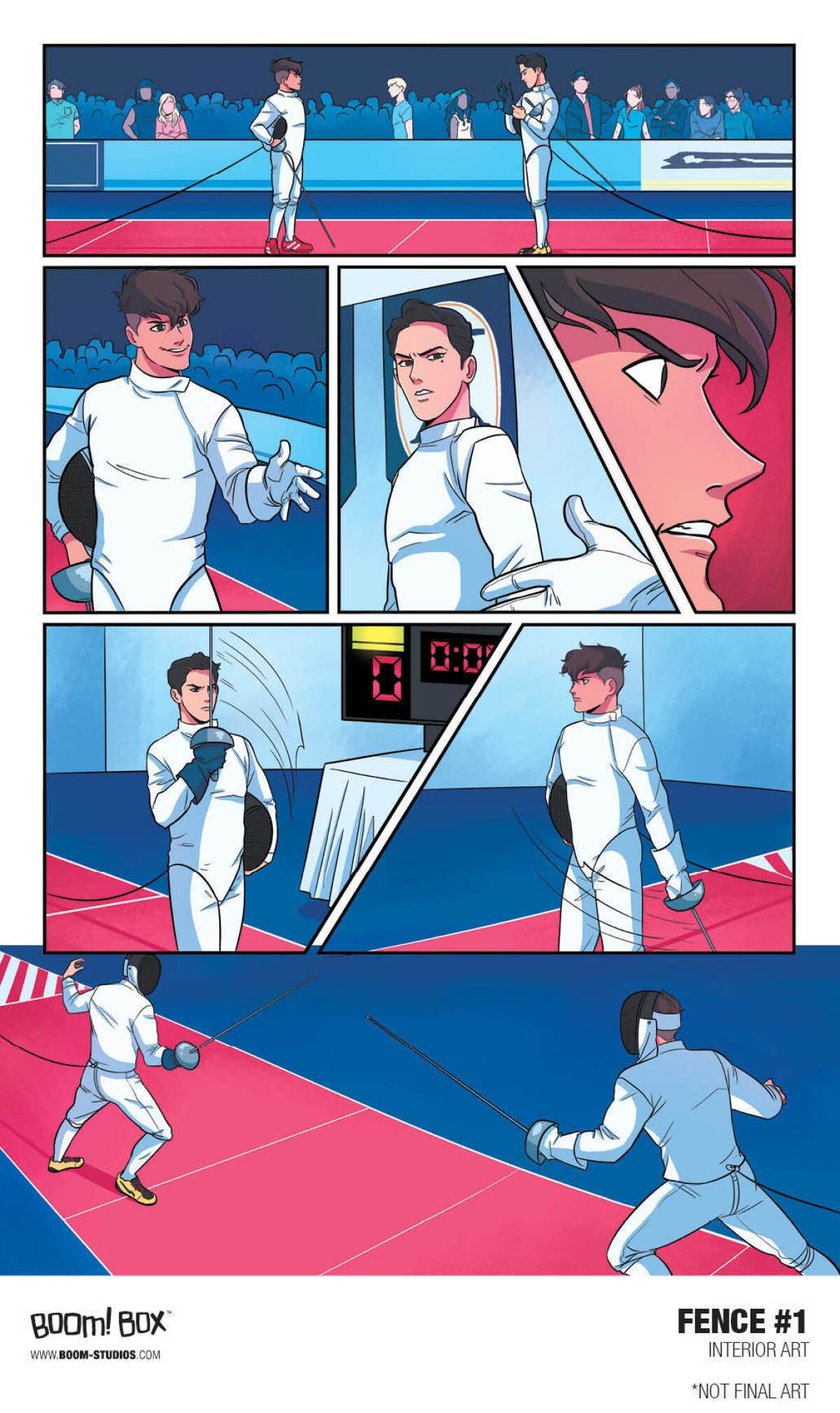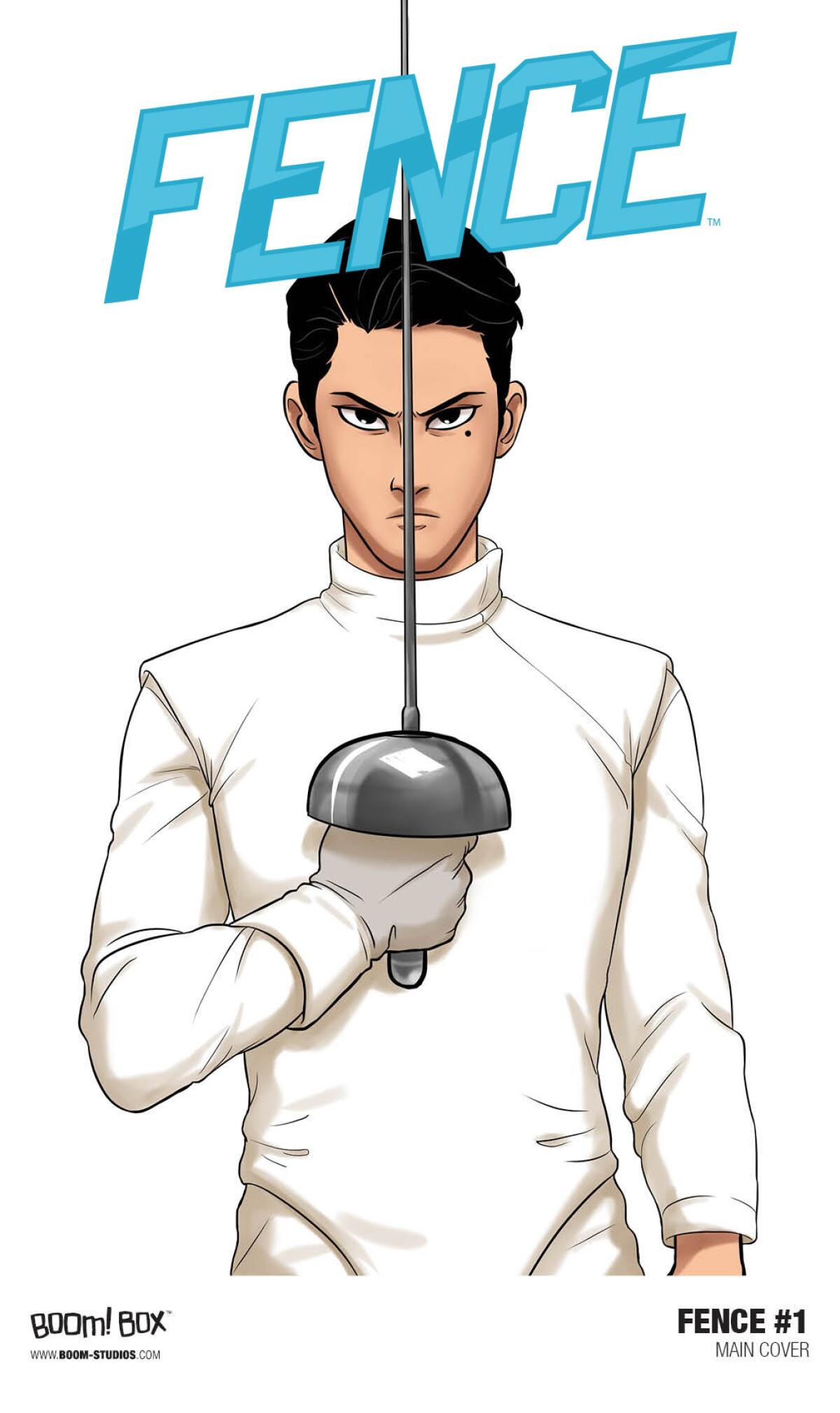Q&A: C.S. Pacat announces new comic series ‘Fence’
- Share via
In the grand tradition of sports manga and anime including “Haikyū!!,” “Kuroko No Basket,” “Slam Dunk” and “Yuri on Ice” comes “Fence” by author C.S. Pacat and artist Johanna the Mad. This new comic series from Boom! Studios’ Boom! Box imprint is slated to hit local comic shops in November.
“Fence” follows the rise of 16-year-old outsider Nicholas in the world of competitive fencing at an elite boys school. “It’s all about the world of fencing,” said Pacat. “The elegance, the danger, the high stakes of what’s essentially a combat sport.”
“It’s also very much about the characters and all the things that sports narratives can bring out in them like intense rivalries, lifelong friendships,” added Pacat. “As well as romance between teammates.”
For Pacat, who is best known for her “Captive Prince” novel series, “Fence” is a dream project that combines her love of comics, fencing and through art.
“I had been a fan of Johanna for a really long time,” Pacat said. The author can specifically recall the piece of Mulan fan art from Johanna that drew her to the artist’s work. “It was like a modern day Mulan dressed in really tomboyish, modern clothes with her boyfriend happily in tow. I instantly became a fan, this was years ago.”
The admiration is not one-sided. Part of the appeal of “Fence” for Johanna was collaborating with Pacat, but that was not the only factor that drew the artist to the project.
"Those who’ve seen my art know I’m super into LGBTQ stories,” said Johanna over email. “This story just clicked with me.”
Pacat discussed “Fence,” her passion for fencing and her love of fan art over the phone from Australia.
How did “Fence” come to be?
It started with the idea. I fenced épée in high school and just fell in love with the sport. It’s solo combat and intensely strategic and psychological. When you’re fencing it’s just you and your opponent and you’re making split-second decisions with everything on the line.
That was a fantastic premise for a story of some kind.
I lived in Japan for about 6 years and got really into sports comics. Even though it’s just an emerging genre here, it’s a super popular genre over there. Sports comics like “Haikyū!!,” which is about volleyball, and “Hikaru no Go,” which is about go, are some of my favorite comics of all time.
Who are the characters of “Fence”?
The main character is Nicholas. He’s sort of talented but roughly trained, he has the potential to be a world-class fencer but only if he can learn discipline and control.
Unknown to everyone else in the comic, he's the illegitimate son of U.S. fencing Olympic champion Robert Coste. His half-brother is Robert’s legitimate son, and fencing golden boy Jesse. Those two guys have never met before.
Nicholas grew up in tough conditions and gets in trouble a lot. He’s often in detention but he loves fencing. He's drawn to it out of a kind of yearning for his father.
As a result of his passion he gets a scholarship to an elite boys school called Kings Row where he's a fish out of water initially. But he learns to make friends and improve along the way.
The other main character is Seiji. Because I fell in love with sports comics in Japan, it just made sense to make the best fencer on the team Japanese.
Seiji is like a young fencing prodigy. He’s 16 years old and he's been training since the age of 6. All the other fencers either want to be him or beat him. But because of his talent, he's somewhat isolated. He spends his time with adult fencers or with coaches. Until he meets Nicholas he's lived quite an isolated life that's only about fencing and winning.
Then there's the supporting cast.
We've got Aiden the mean playboy with a heart of gold, and Harvard, the goodhearted team captain. There's Coach Sally, a former Olympic fencer in sabre. Her lifelong rival in sabre, Alessandra, is coach of the rival team school. So Nicholas and Seiji will be facing off against their coach’s greatest rival and her team throughout the series.
How detailed will the fencing itself be in “Fence”?
I think one of the amazing things about these kinds of narratives — much like when you watch a ballet movie or a dance movie — is that feeling of just being immersed in a different world and learning its rules. The comic will introduce the world of fencing, I hope, to the reader.
I'm working with a really great épée coach in Australia to choreograph all the fight scenes. And I've been working with him on the fencing characterization of each boy, so they'll all have different strengths and weaknesses that will evolve throughout the narrative.
There’s going to be some romance between the boys. How important is it for you to portray queer love stories in your work?
Really important. It's something that I'm interested in doing across all my art.
I feel like there's so much potential, especially within sports, which can be quite male-dominated but in a way that's often excluding other groups. As a female sports fan you can sometimes feel marginalized [because] sports are generally packaged only for the male gaze.
I was really interested in taking a lot of the energy within sports that are often sublimated and just bring them out to the surface. That includes the female gaze approach and also includes openly queer characters. But not in any sort of sad way. I hope to be writing something that's very joyously and unabashedly queer. That's very important to me.
“Captive Prince” is a fantasy series. How is writing something more strictly grounded in the real world different?
The joy of fantasy is you can create something that is completely new and you're not bound by the scriptures of the real world. Even when you do research, you can get away with smudging it just a little if you need to. Whereas in “Fence,” especially because I was so invested in the accuracy of the fencing, there’s no smudging allowed.
And my coach has been extremely strict with me in terms of what would and would not pass muster. So there is a much stronger framework that I had to work within.
There is one way in which it's been unexpectedly similar. One of the things that I love about fantasy is the slightly larger than life storytelling and the powerful archetypes. That escapist, heroic nature of fantasycould be included in “Fence.”
That's another reason why having a diverse cast was very important to me. When you're writing heroic narratives it's very important to make sure that you have a story where everyone can feel as though they can be a hero.

You mention becoming a fan of Johanna the Mad’s fan art. What is the significance of this fan community?
For me that community is one of most vibrant creative communities that exists. Especially because that’s how I kind of came up as well. “Captive Prince” was an original online serial before it was picked up by Penguin.
When you’re a creator online, you’re making work outside of a commercial framework. You’re often anonymous or pseudonymous and that gives you a kind of creative freedom that everyone in that space can feel. You’re just creating in a completely unrestrained way and as a result that kind of artwork is incredibly exciting.
I think that when a dollar sign is attached or even when your name is attached, those pressures change things.
That’s why I love the kind of art that is generated out of that community. I really wanted to work with someone who came up in that community, who was still in touch with those passions and that kind of creative freedom of expression.

The biggest entertainment stories
Get our big stories about Hollywood, film, television, music, arts, culture and more right in your inbox as soon as they publish.
You may occasionally receive promotional content from the Los Angeles Times.








